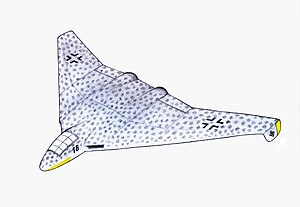Loading AI tools
Type of aircraft From Wikipedia, the free encyclopedia
The Focke-Wulf 1000x1000x1000, also known as Focke-Wulf Fw 239,[1] was a twinjet bomber project for the Luftwaffe, designed by the Focke-Wulf aircraft manufacturing company during the last years of the Third Reich.
| Focke-Wulf 1000x1000x1000 | |
|---|---|
 | |
| Fw 1000x1000x1000 B | |
| Role | Bomber |
| Manufacturer | Focke-Wulf |
| Designer | H. von Halem and D. Küchemann |
| Status | Terminated by end of war |
| Number built | None |
Their designation meant that these bombers would be able to carry a bomb that weighed 1000 kg for a distance of 1000 km at a speed of 1000 km/h.
Focke-Wulf produced three different designs of the project that would have been powered by two Heinkel HeS 011 turbojet engines. The innovative-looking series of jet bombers was designed by H. von Halem and D. Küchemann.[2] The project was cancelled because of the surrender of Nazi Germany.
The Focke-Wulf 1000x1000x1000 project had three different variants. All of them were twin-jet bombers that would be powered by two Heinkel-Hirth He S 011 turbojets.
Jet-powered bomber project that looked conventional. It had thin wings, swept back at 35 degrees.
Data from Herwig & Rode[3]
General characteristics
Performance
Armament
A flying wing design with a small fuselage containing the cockpit and the front undercarriage wheel.
Data from Herwig & Rode[3]
General characteristics
Performance
Armament
A twin jet bomber project with a crew of three quite similar to the Fw 1000x1000x1000 A with a wingspan of 12.65 m and a length of 14.2 m.
Data from Herwig & Rode[3]
General characteristics
Performance
Armament
Related lists
Seamless Wikipedia browsing. On steroids.
Every time you click a link to Wikipedia, Wiktionary or Wikiquote in your browser's search results, it will show the modern Wikiwand interface.
Wikiwand extension is a five stars, simple, with minimum permission required to keep your browsing private, safe and transparent.